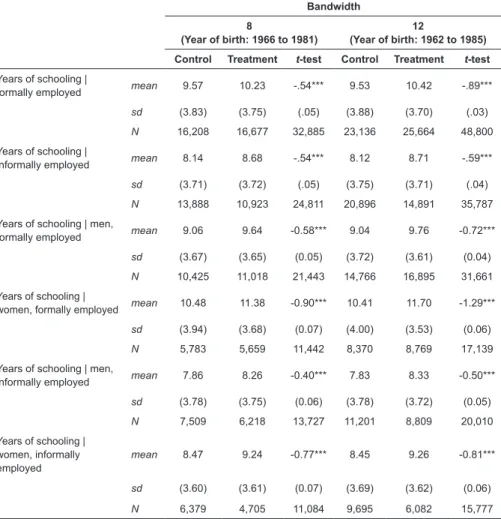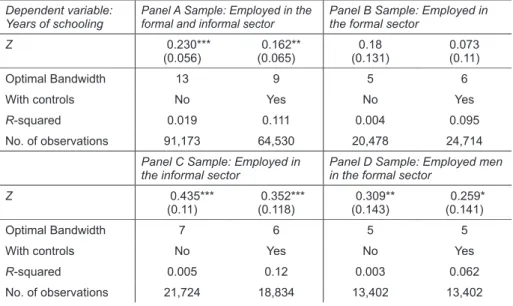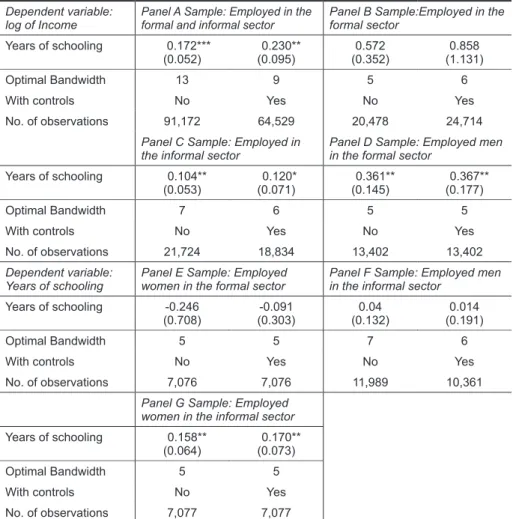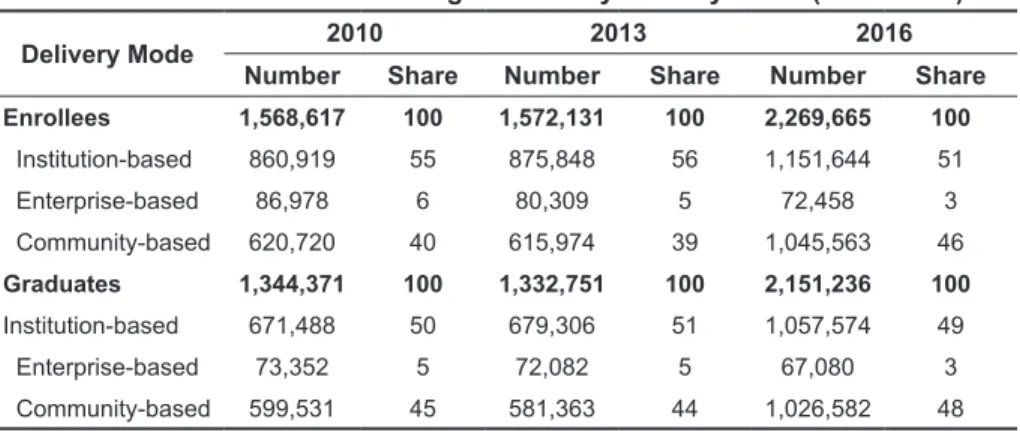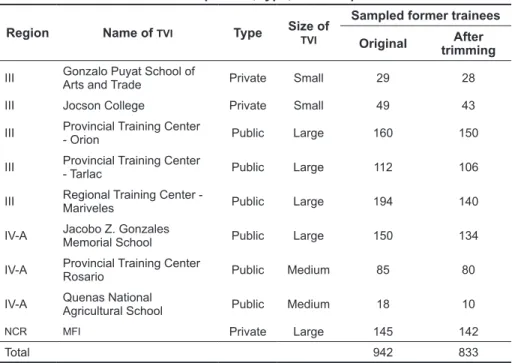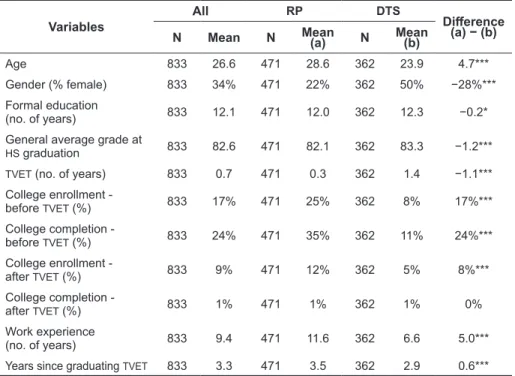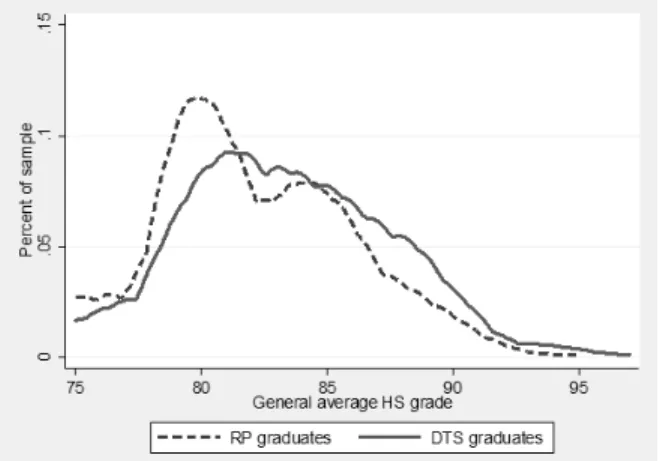The Editor, The Philippine Review of Economics, Rm 237, School of Economics, University of the Philippines, Diliman, Quezon City, 1101. Several methods can be undertaken to determine the optimal bandwidth h* and the order of the polynomial.
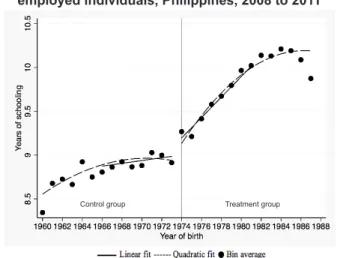
Results and Discussion
The results in the informal sector are quite different from those in the formal sector. The findings in the informal sector are quite opposite to those found in the formal sector.
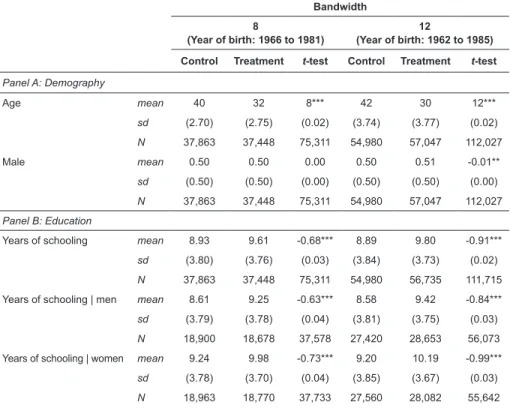
Conclusion
1998] "Endogeneity of schooling in the wage function: Evidence from Rural Philippines", Food Consumption and Nutrition Division Discussion Paper No. 2006] “Education Policy Reform, Local Average Treatment Effect and Returns to Schooling from Instrumental Variables in the Philippines”, Applied Economics.
Who benefits from Dual Training Systems?
Evidence from the Philippines
- Introduction
- Dual Training System in the Philippines
- Analytical approach
- Data used for analysis and descriptive statistics
- Estimation results on labor market outcomes of DTS
Labor market outcomes of DTS compared to RPs were assessed using survey data. However, the coefficient of the interaction term between DTS and HS overall grade point average is not statistically significant for the probability of employment.
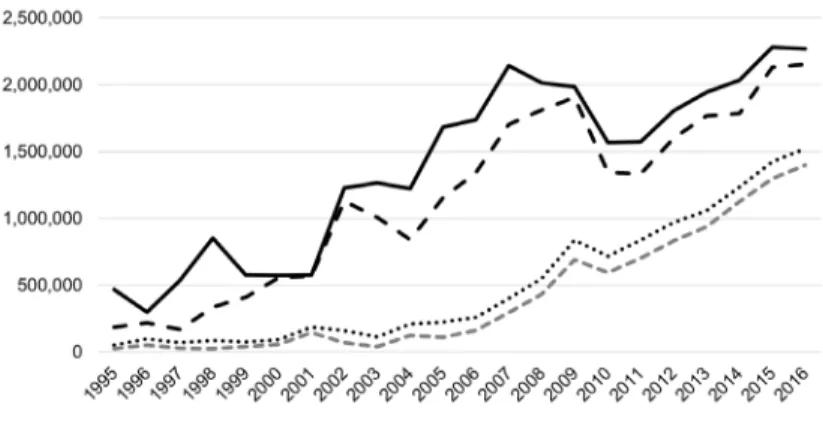
The impact of Philippine monetary policy on domestic prices and output: evaluating the country’s transmission channels
Literature review
There is a clear heterogeneity in the effects of monetary policy on macroeconomic indicators such as prices, output and employment. In the case of the Philippines, the issue of heterogeneity is particularly important because empirical studies on the price and output effects of monetary policy are limited.
Data
The augmented Dickey-Fuller [1979] test is used to find the presence of a unit root (or stochastic trend) in the data. Policy Rate (PR) – The BSP's primary tool that conducts OMO and signals the prevailing interest rate of its monetary policy. Domestic credit to the private sector (percentage of GDP) – represents the response to adjustments in the RRP, as this is the amount of credit circulating in the private sector of the economy.

Methodology
In the remaining parts of the methodology, the notation relating to exogenous variables is removed for the sake of simplicity. Alternative sample arrangements and modifications are used in the sensitivity analysis in the robustness test section. In general, this specification is found in most of the literature, mimicking the framework of Kim and Roubini [2000] .
Empirical results and discussion
There was also a strong appreciation of the exchange rate in the third quarter (0.88 percentage points). Second, non-recursive ordering is only one way to represent the transmission of monetary policy in the Philippines. However, there are some differences in the time courses and IRF magnitudes from the LP method that are worth noting.
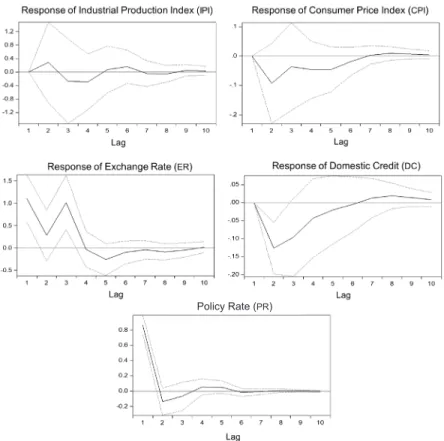
Concluding remarks
2006] "The Effect of Monetary Policy on Real Commodity Prices", National Bureau of Economic Research Working Paper (12713). Allon [2016] “Revisiting the Transmission Mechanisms of Monetary Policy in the Philippines”, Monetary Policy Transmission Mechanism in the SEACEN Countries. 2015] “Increased Financial Intermediation in the Philippines: Some Implications for Monetary Policy”, Bank for International Settlements (83q).
The BSP's Forecasting and Policy Analysis System
Forecasting and Policy Analysis System ( FPAS )
2 Please refer to the Inflation Targeting FAQ for a more detailed description of the BSP's inflation targeting framework, available online [“BSP and Price Stability” 2020]. Because the SEM is equivalent to the inflation equation in the MEM, it can be considered the reduced form version of the MEM. The balance of risks to the outlook is graphically presented using a fan chart (Figure 6).4 The fan chart shows the probability of different outcomes for inflation over the forecast horizon.
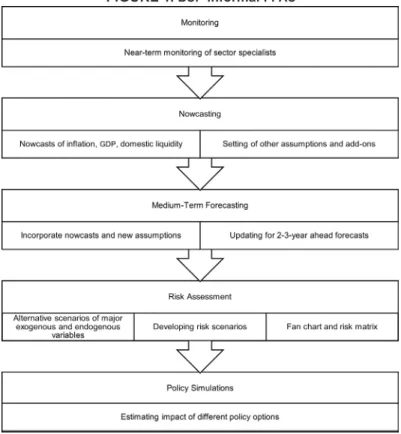
Forecast evaluation
The unbiasedness of the inflation forecasts can be tested by regressing the forecast errors against a constant term (Equation 1). The results of the test indicate that there is no consistent pattern in the forecast errors of the BSP's inflation forecasts. However, the deviation from the forecasts of actual inflation was relatively lower using the BSP's forecasts compared to the private sector and the IMF over the different forecast horizons.
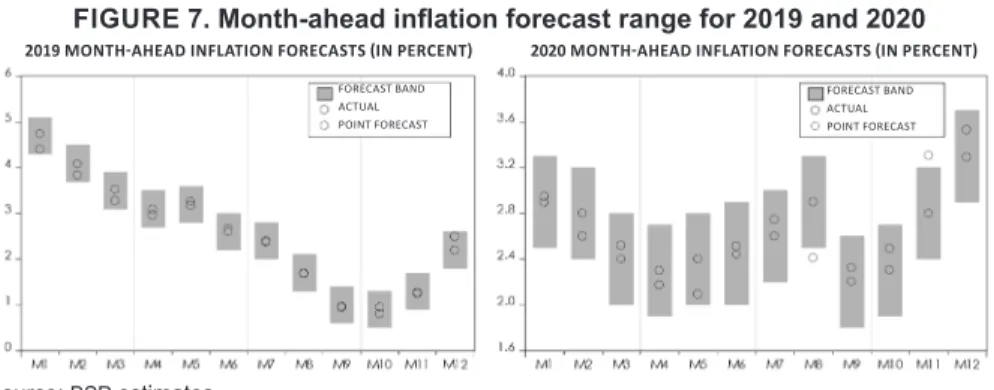
Communication of forecasts
Unlike other central banks, the BSP publishes an inflation forecast for the current month on the last business day of the month, via the BSP website and social media accounts. The practice of releasing a month-ahead inflation forecast began when the BSP switched to inflation targeting in 2002. The statement aims to focus on the BSP's medium-term view on inflation, away from short-term inflation developments.
Future work
Equally important, the TA will help strengthen the DER's ability to transition to the PAMPH as the BSP's workhorse model for monetary policy analysis and forecasting. Zarnowitz [1969] “The Evaluation of Economic Forecasts” in Economic Forecasts and Expectations: Analysis of Forecasting Behavior and Performance, pages 3-46, National Bureau of Economic Research, Inc. 2002] “The Role of Models and Probabilities in the Monetary Policy Process,” Brookings Papers on Economic Activity 2002 no.
Azcárraga’s critique of mercantilism
Azcárraga himself
Returning to the Philippines, he held several positions in the judiciary, including an appointment as prosecutor of the Audiencia and the Naval Court. During this period he was an outspoken advocate of free trade policies, particularly advocating the abolition (desestanco) of the tobacco monopoly in the Philippines, a measure finally passed in 1881. Manuel's official biography notes "the powerful influence of his brother Marcelo" in promoting his career.
Liberalism and free trade ideas
Referring to characteristic elements of the Industrial Revolution (a term that of course did not exist at the time), he calls trade taxes “incompatible with steam and electricity” and “an anachronism in the present century” [LC 215] and looked forward to their completion. of the Suez Canal as a promising future for trade between the Philippines and Europe [LC 15]. 10 In the US, Azcarraga [LC 202] saw the growing influence of the Democratic Party as a hopeful sign, which favored free trade and was associated with agricultural interests in the southern (formerly slave-owning) states. 12 Smith also refers to mercantilism as the “doctrine of the balance of trade” [WN IV.iii.c.2].
The question posed
After all, many of these supposed British advantages did not arise until long after Spain had taken possession of the Philippines (that is, in the late 18th and 19th centuries). This argument included the possibility that – in the absence of sufficient Spanish or Mexican interest in the Philippines – other countries could have picked up the slack. Azcárraga's advocacy for free trade is unique in that he proposed liberalizing not only Spanish trade policies in the Philippines, but also investment and possibly immigration policies.
Four epochs
Legarda also tempers enthusiasm at the prospect that the Manila Spaniards could have traded directly with mainland China—a possibility that Azcárraga believed existed and should have been pursued—given the prohibitions imposed on foreigners in the major Chinese ports and the resistance of the Portuguese who wanted. to protect theirs. Subsequent attempts by various Mexican viceroys to relieve the costs of Manila society as private individuals were resisted and failed. What is not in doubt is that even the "sampan trade" alone enabled a rapid expansion of the value of trade between Manila and the Americas, where galleons were dispatched (in the early decades, at times more than two per year) not only to Acapulco, but also to Peru and the Isthmus of Panama (ie Tierra Firme).
Critique of restrictions on the galleon trade
His detailed account of the exchange of petitions and counter-petitions between the Manila and Cadiz lobbies is a valuable summary record. The relaxation of these limits has been the subject of the Manila business community's numerous petitions to the court. We believe it would also have been better for the Americans and our navigation in general, although it would necessarily have deprived Manila of the advantages indicated.
Manila as center for the carrying trade
Apart from the restrictions on the frequency, cargo and destinations of galleons, already mentioned, Spain could not actively seek Asian goods at the source. The failure of the paper money system, however, led the Ming dynasty to require that tax obligations be discharged on unwrought silver bullion, thus effectively acquiring the commodity. However, this failed to flourish, due to opposition from the Portuguese, who were jealous of the trading privileges of their Macao post.
Critique of Basco’s mercantilism
However, Azcárraga praises the establishment of the Company and the changes in its policy. However, in relation to the Company's ventures to support craft production, Azcárraga is unequivocally critical. While acknowledging the Company's benevolent intent, Azcárraga criticized its plans to export more than just the Philippines.
An implicit theory of trade and development
In the excerpt above, Azcárraga attributes at least part of the company's economic despair to its failure to focus its promotional activities on those products where the country had a natural advantage (ie agricultural or "colonial" products). In the case of the Philippines, these distortions must be understood as arising from the mercantilist rules that stifle trade. Once again, the parallels between the lines of this implicit debate and those between liberal and heterodox economists in the second half of the 20th century are striking.
The role of foreign capital
But the crucial economic role he attributed to foreign capital is most evident in his discussion of the fourth era, the liberal phase of his periodization. Ultimately, despite the objections of the Manila lobby, the regional ports of Zamboanga, Iloilo and Sual (all in 1855) and later Cebu (1860) were finally opened to international shipping. He argues that Spanish capital already enjoyed initial advantages, especially in the form of the flag discrimination baked into the tariff system and the close contact of the Spanish with the indigenous population.
Relation to Smith’s ideas of trade and development
Smith's skeptical view of the transportation trade follows directly from his idea that foreign trade was a consequence rather than a cause of prosperity. The return on foreign trade of consumption is very rarely as rapid as that of domestic trade. That part of the capital in any country which is employed in the transport sector is entirely withdrawn from supporting the productive labor of that country, to support it in some foreign country.
Welfare effects
As previously quoted, he predicted that, on the basis of an unrestricted carrying trade, "the wealth of the city would in no time have grown annually in proportion, and there would have been abundant capitals which, devoted to agriculture, would have products would yield for maintaining that an export trade and consequently also the import trade" [LC 95]. So that when there is a great harvest it will be easy and speedy to bring the grain for sale to neighboring markets to the great advantage of the producer, and when there is scarcity in the islands, it is equally easy to procure it from other countries, so that this much-needed food may always retain a moderate price. He expected only a minor disruption to the country's rice surplus status due to further expansion of the other major export commodities, as he believed that farmers would always place a high priority on growing the all-important food staple for their needs.
The customs house—the last obstacle
This proposal must be considered in the context of the then existing system in which Spanish citizens were exempted from paying poll tax or tax. Azcárraga then focused on eliminating the long-standing tobacco monopoly,48 the main source of revenue until then. Again aware of the potential loss of revenue in the transition, he proposed abolishing the monopoly only after imposing taxes on other exporting provinces.
Sequel and significance
The quoted excerpts from the Libertad are my translations from the original Spanish; page numbers refer to the locations of cited material in the original publication. 2020] “Changing Patterns of Trade in the Wealth of Nations: Adam Smith and the Historiography of International Trade Theory”, Journal of the History of Economic Thought. 2008] “The Politics of the Great Debate in the 1950s: Economic Decolonization in the Philippines Revisited,” Kasarinlan: Philippine Journal of Third World Studies.
Book Review
Before and during the AFC
Premature" financial globalization, without the appropriate regulatory and supervisory mechanisms to manage a rush of short-term financial flows, resulted in a "build-up of vulnerabilities" [Khor, Guinigundo and Kawai, making these Asian economies susceptible to the occurrence of a itself - Meets poor equilibrium The Philippines, which did not experience as much capital inflow as its neighbors and already had some of the necessary regulatory and supervisory mechanisms in place as part of the lessons learned from its own balance of payments-cum-financial crisis in the early 1980s' ers, was relatively insulated from the negative effects of the AFC (Part III, Chapter 5).The disregard of the warnings of the Mundellian Trilemma in the face of openness of financial accounts and pegged currencies (to the USD), combined with the excessive focus on the current account instead of the capital account, resulted in a misjudgment of the nature and severity of the crisis and a subsequent mishandling of the IMF's policy prescriptions and an aggravation of the adverse effects of the AFC.
Post- AFC recovery
During the GFC , Post- GFC and Taper Tantrum
This led the IMF to reassess its intervention strategy, shifting from highly intrusive "structural conditionality" to "national ownership" of conditional IMF programs. To support CMIM's operations and conduct economic surveillance in ASEAN+3, the ASEAN+3 Macroeconomic Research Office (AMRO) was established in 2011, and its scope and impact have only expanded through the COVID-19 pandemic.
